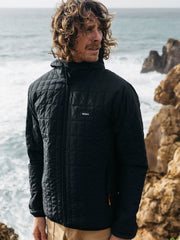With a population of around 60 people, Fair Isle is one of Scotland’s most remote islands. Nationally and nostalgically renowned for its mention on The Shipping Forecast, the tiny land mass is famous for bird watching, lighthouses and, of course, its iconic knitwear.
Story of the Fair Isle Knit
28.08.24
4 min read
Written by Lottie Lewis
Fair Isle knitting is a technique that can be dated back to the 18th Century. Wives of fisherman on the island would knit patterned hats for their husbands, keeping them warm in the harsh Scottish weather, with the colourful designs making the skipper more easily seen from both land and sea. Typical Fair Isle knits follow an ‘OXO’ pattern, with local knitters also incorporating motifs inspired by their surroundings, such as ram’s horns, flora, fauna and marine life. Fair Isle knitters were traditionally women, and their creations typically featured two colours per row.
Traditional Fair Isle colours were bright and vibrant, even in the 1900s. These colours were originally achieved through natural dying methods, using imported indigo to make the yarns blue, madder root mixed with native lichen to produce red, and yellow dye from bistort, a flower that also grows on the island. Fair Isle garments were knitted from hand-spun yarn created from Shetland wool, a fibre taken from the fleece of Shetland sheep. The sheep produce wool that ranges naturally from Shetland black (brown), grey, brown, fawn and white. These yarns are also used in their natural form in Fair Isle knitting.
Fair Isle patterns began to reach the rest of the world during the 19th Century when fisherman from the North Sea ventured to the area. Loved by visitors, they were purchased from the local artisans and taken home as souvenirs. Over time the demand for Fair Isle knitwear grew.
Showcased by British royal Prince Edward in the 1920s and adopted by influential fashion designers such as Chanel, Versace, Balenciaga and Ralph Lauren, the humble Fair Isle knit has been catapulted into popular culture, now being worn by both celebrities and the average family across the world. With knitting patterns readily available, mother’s would create matching Fair Isle jumpers for themselves and their husbands, and knit smaller versions with the left over wool for their children, too. Whilst true Fair Isle knitting is now only practiced commercially by three women on the island, the design is a household staple across the world.
The design team at Finisterre spent endless hours researching the Fair Isle knit. We wanted to create a jumper that was warm, wearable, authentic and paid homage to the original knitters of Fair Isle patterns. Here’s an insight into the design process undergone by the knitwear team.
We sat down with Finisterre Knitwear Designer, Becky Cox, to discuss the inspiration behind the our new Fair Isle knits.
What was the process of developing the Fair Isle knit pattern for Finisterre?
The process started by looking through traditional Fair Isle graph books, exploring the history of knitting in the British Isles and looking at old imagery of the knits...
Fair Isle patterns are all about the colour. The mixing of colours per row allows you to create and build an intricate pattern. The Shetland Wool colour card was great to work from, with many colour options to choose from. The next step was to select a variety of colours that work well together and sit back with the seasonal colour palette of autumn. We decided to use a natural base with the multi colours built up in the repeat pattern.
Were there any particular challenges in recreating this traditional style?
There is so much inspiration out there and so many variations of patterns and colour ways - the hardest part was finalising just two fair isle patterns for the season! We were given the challenge of taking a traditional design and putting a modern twist on it. I feel like we achieved this through the silhouette and unexpected colour combinations.
















































































